Welcome to the colorful world of Kantha stitch, where threads carry stories and old sarees find a second life as chic contemporary jackets. The Kantha stitch of Bengal is more than just embroidery; it is an art of recycling with elegance. Imagine your grandmother’s saree transforming into a stylish jacket that could easily turn heads on a college campus or even at a fashion runway.
In fact, according to a report by the Ministry of Textiles, hand embroidery like Kantha contributes to nearly 16 percent of India’s handicraft exports. That means the world is already in love with it. What makes Kantha special is its simplicity, just running stitches, yet powerful enough to make plain fabric look like moving art.
And let’s be honest, who would not want to wear a jacket that carries both heritage and style? So, let’s stitch through time and explore how old sarees are making the coolest comebacks with Kantha stitch.
What is Kantha Stitch? A Craft Rooted in Bengal’s Culture
The Kantha stitch of Bengal is a true example of how something simple can become timeless. At first glance, it is just a running stitch, but in reality, it is much more than that. This art is centuries old, practiced by women who wanted to turn old sarees, dhotis, and cloth scraps into something beautiful and useful. Think of it as the original version of “upcycling,” way before the fashion industry made it trendy. With just a needle, thread, and lots of patience, they stitched stories, emotions, and everyday life onto fabric.
Today, Kantha stitch is not only about tradition but also about style. Jackets, scarves, bedspreads, and bags with Kantha designs are popular not just in India but around the world. According to the Export Promotion Council for Handicrafts, Indian embroidery crafts like Kantha contribute significantly to a billion-dollar industry, proving that humble stitches from Bengal have truly stitched their mark on global fashion.
The Simplicity Behind the Art
Kantha stitch is one of the easiest embroidery styles to recognize. Just tiny running stitches that, when repeated, form stunning patterns. No complicated tools, no fancy machines, just:
- Old fabric layered together
- Thread in vibrant colors
- Simple running stitches
- Creative hands and patient minds
Yet, these stitches can create everything from flowers and birds to geometric patterns and mythological scenes. What started as a household necessity has now become a design statement.
Kantha Stitch of Bengal: A Cultural Treasure
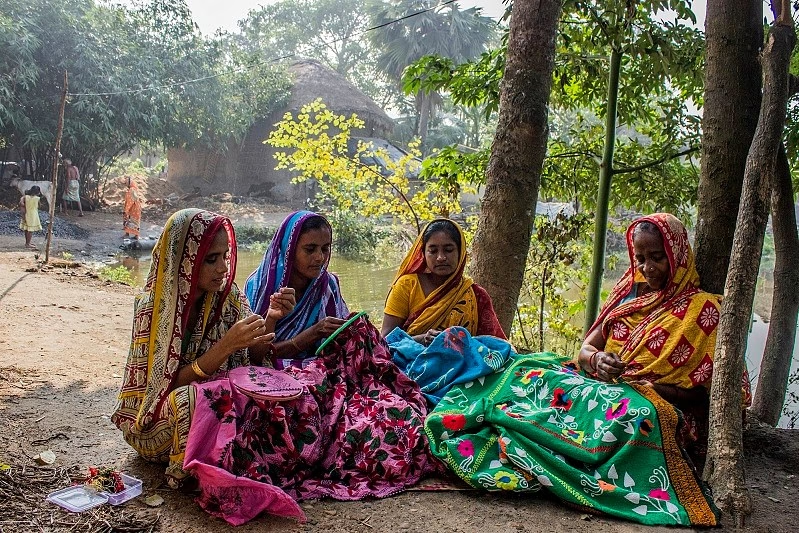
- The Kantha stitch of Bengal is still practiced in villages like Bolpur and Murshidabad, where local women carry forward the tradition with pride. Each design feels alive because it is handmade with care and tells a story.
- Many Kantha creations are passed down from mothers to daughters, turning them into heirlooms. This makes every piece deeply personal, with family history stitched into the cloth itself.
- Unlike machine-made patterns, no two Kantha products are the same. Each jacket, saree, or quilt has its own charm, making it truly one-of-a-kind.
- Global designers are now embracing Kantha stitch of Bengal for eco-friendly and sustainable fashion. By using recycled fabrics, they highlight both creativity and responsibility.
- Once considered a “grandma’s skill,” Kantha is now turning into a global style symbol. From sarees to contemporary jackets, the Kantha stitch of Bengal proves that tradition can be timeless and fashionable at the same time.
The History Woven in Threads
The Kantha stitch of Bengal is like a time machine made of fabric and thread. It carries centuries of stories, stitched patiently by women who probably never thought their home craft would one day appear on international runways. The beauty of Kantha lies not only in its patterns but also in its history. It was born in rural Bengal, where creativity met necessity. Women reused old sarees and cloth scraps to make quilts, covers, and clothing.
In a way, they were the first champions of sustainable fashion long before the term even existed. According to UNESCO, Indian embroidery traditions like Kantha have been practiced for more than 500 years and remain a living cultural heritage. Today, the Kantha stitch is admired across the world for its simplicity and elegance. From a humble household craft to a global design statement, the Kantha stitch of Bengal truly shows how culture can be stitched into every thread of fabric.
Origins in Rural Bengal Homes
The Kantha stitch of Bengal did not start in royal palaces but in small rural homes. Long ago, village women created Kantha Stitch by reusing old sarees and dhotis. Shopping was rare, so they found creative ways to recycle fabric into something useful and beautiful.
Women would place layers of worn-out clothes together and join them with simple running stitches. These stitched layers turned into cozy quilts that kept families warm during winters. Over time, this habit became an art form known as Kantha stitch.
Before we explore further, let’s look at how Kantha grew as a tradition:
- Women stitched in groups, chatting and sharing daily stories.
- It was not just sewing; it was a way to bond as a community.
- Mothers passed down the skill to daughters, keeping the Kantha Stitch of Bengal alive.
Even today, Kantha stitch is more than just thread and fabric; it is a symbol of care, creativity, and culture that has survived through generations.
Stories and Symbols in the Stitches
The Kantha Stitch of Bengal is not just thread on cloth; it is storytelling with a needle. Every Kantha Stitch holds meaning, whether it shows flowers, birds, or even scenes from myths. These designs are not random; they are full of imagination and everyday life moments.
Long ago, women stitched their hopes, dreams, and beliefs into fabric. The motifs carried deep meanings and made Kantha more than just embroidery.
Before we dive deeper, let’s see some of the most common and loved symbols in Kantha:
- The sun for energy and new beginnings.
- Trees for growth, fertility, and protection.
- Animals and birds for nature, freedom, and good luck.
- Folk tales and myths stitched as stories for the next generation.
Even today, designers use these symbols in jackets, scarves, and handbags. According to the Craft Revival Trust, Kantha embroidery is among the most exported crafts from India, showing how the stitched stories of Bengal keep traveling the world.
From Sarees to New Creations
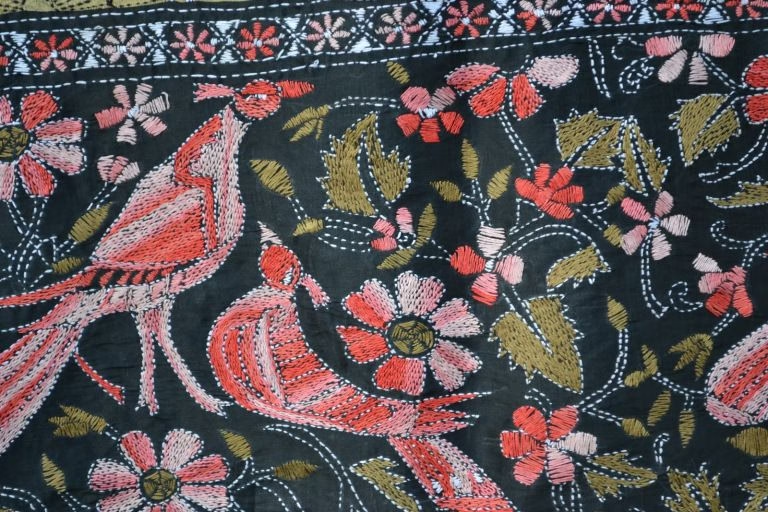
The Kantha stitch of Bengal has always been proof that fashion does not need to be wasteful. Long before the term “recycling” became trendy, women in Bengal were already turning old sarees into treasures with nothing more than a needle and thread. Instead of discarding worn-out fabrics, they stitched them layer by layer, transforming them into quilts, covers, and clothing. This art was born out of practicality but ended up becoming timeless. According to the Handicrafts Board of India, almost 20 percent of hand-embroidered exports today have roots in traditional crafts like Kantha.
That means the world has started to notice what Bengal’s women knew for centuries; old fabric still has new stories to tell. Today, what was once just household stitching is now high fashion. From sarees becoming stylish jackets to bedspreads that look like art pieces, Kantha stitch proves that creativity stitched with love never fades.
Recycling Old Sarees into Something New
In Bengal, women found a beautiful way to reuse old sarees. Instead of throwing them away, they gave these fabrics a second life. By using the Kantha Stitch, layers of sarees were joined together to make something useful and artistic at the same time.
These stitched layers often turned into cozy quilts that kept families warm on cold nights. But the fabric was not just recycled; it was decorated with love. Every piece of reused cloth became a canvas filled with creativity.
Before we look at its modern touch, let’s see how women used Kantha in their daily lives:
- Old sarees were stitched with Kantha to make quilts and blankets.
- Simple stitches turned plain cloth into designs of flowers, birds, and tales.
- Every fabric carried a personal story from the maker’s imagination.
Today, designers follow the same idea, turning old sarees into stylish jackets, scarves, and handbags. The Kantha Stitch of Bengal proves recycling keeps both fabric and culture alive.
Why Kantha Loves the Idea of Sustainability
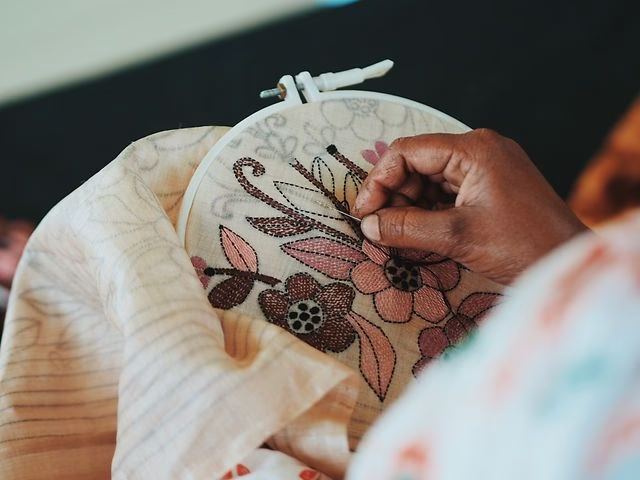
The Kantha Stitch of Bengal has always carried the spirit of sustainability. It started as a way for women to reuse old fabrics and turn them into something beautiful and useful. Long before people talked about eco-friendly fashion, Kantha stitch was already showing how to recycle with creativity.
Unlike fast fashion, Kantha products are handmade, long-lasting, and kind to the environment. They remind us that fashion can be both stylish and responsible.
Before we see how Kantha fits into today’s eco-movement, let’s look at why it is called sustainable:
- Made from recycled fabrics, mostly old sarees and dhotis.
- Created with hand stitches, reducing the need for machines.
- Durable and long-lasting, unlike fast fashion items.
- Keeps cultural traditions alive while protecting the planet.
With global demand for sustainable fashion rising, Kantha stitch is gaining worldwide attention. From old sarees to trendy designs, the Kantha Stitch of Bengal proves sustainability is timeless wisdom, not just a modern trend.
Kantha Meets Fashion
The Kantha stitch of Bengal has walked a long way from quiet village homes to global fashion ramps. What began as women reusing old sarees is now admired as a high-fashion statement. The beauty of Kantha lies in its ability to fit anywhere, whether it is a quilt at home or a jacket at a luxury boutique. Designers love it because it brings stories and authenticity, while customers adore it because it feels unique.
According to the Indian Ministry of Textiles, traditional embroidery crafts like Kantha contribute to a significant share of India’s $3.5 billion handicraft export market. That means people across the world are buying not just fabric but a slice of Bengal’s history. With every stitch, Kantha proves that tradition can travel, adapt, and glow under the spotlight. Who would have thought that grandma’s old saree could strut down a runway and still look fabulous? That is the magic of the Kantha stitch of Bengal.
Sarees Turning into Trendy Jackets
Once kept quietly in cupboards, old sarees are now getting a new life as stylish jackets. With the magic of Kantha Stitch, these jackets become more than just clothes; they become wearable art. Each piece tells a story stitched with care and culture.
Designers love this idea because it blends tradition with modern style. The jackets are light to wear, full of comfort, and carry the rich soul of heritage. What was once an old saree is now a fashion statement loved by people everywhere.
Before we see why these jackets are becoming so popular, let’s check what makes them special:
- Unique designs created with Kantha stitch, featuring flowers, birds, and folk symbols.
- Eco-friendly fashion, giving old fabrics a second life.
- Heritage with style, mixing culture with modern fashion needs.
- Loved by all, from college students to big celebrities.
The Kantha Stitch of Bengal proves that fashion can be trendy, eco-friendly, and deeply connected to tradition at the same time.
The Blend of Tradition and Modern Style
The Kantha Stitch of Bengal has always been about creativity and storytelling. But today, it is also about fashion fusion. Modern designers are using Kantha stitch to add charm and culture to everyday outfits. From dresses and scarves to handbags and jackets, Kantha is finding a new place in global fashion.
A study by the Craft Revival Trust shows that Kantha products are among the most loved Indian textiles in international markets. This proves that Kantha is not just traditional embroidery; it is a global trend.
Before we see how it blends so well, let’s look at what makes Kantha both modern and timeless:
- Trendy outfits like jackets, dresses, and scarves carry Kantha embroidery.
- Cultural motifs like flowers, birds, and stories keep tradition alive.
- Global appeal with designers showcasing Kantha on runways.
- Fashion with soul, mixing heritage and modern style together.
The Kantha Stitch proves heritage never fades; it simply becomes more fashionable with every generation.
The Making of a Kantha Jacket
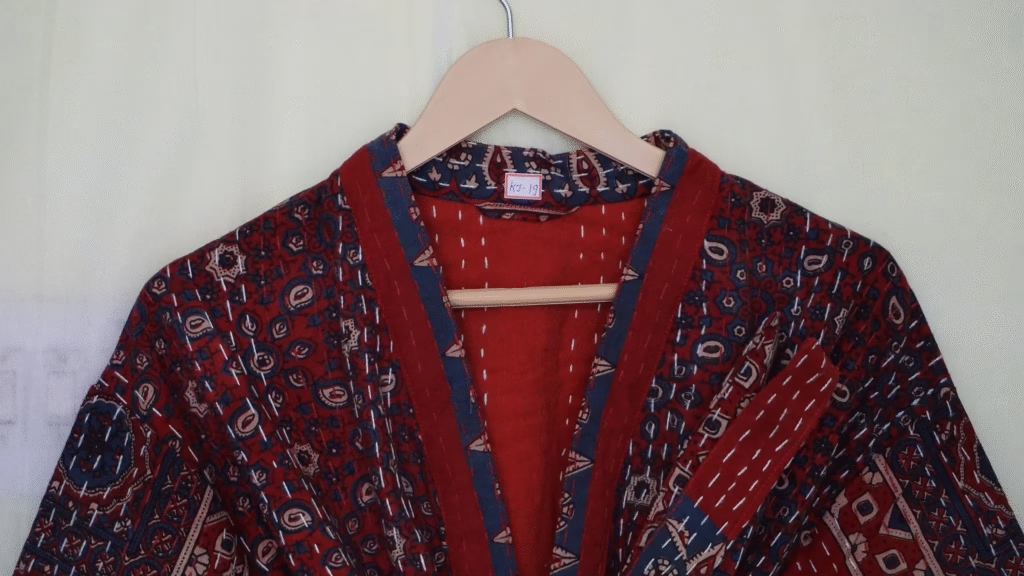
The Kantha stitch of Bengal may look simple, but when it comes to turning old fabric into a stylish jacket, the process is nothing short of magic. A jacket does not just appear after a few stitches. It takes time, effort, and creativity from skilled artisans who know how to bring life into layers of cloth. What started as household embroidery has now grown into a recognized craft that supports thousands of families across Bengal.
According to the Development Commissioner of Handicrafts, hand embroidery like Kantha provides employment to more than a million artisans in India. That means each jacket you see is not only a fashion statement but also someone’s livelihood. The transformation from worn-out sarees to trendy jackets is a story stitched with patience and pride. And honestly, who would have guessed that grandma’s favorite saree could end up looking runway-ready? That is the beauty of the Kantha stitch of Bengal.
The Role of Skilled Artisans
Behind every beautiful piece of Kantha Stitch of Bengal, there are skilled artisans who give it life. These craftsmen and women are the true backbone of Kantha creations, especially the trendy jackets we see today. With patience and love, they spend hours planning patterns, choosing colors, and stitching designs with great care.
The art of Kantha Stitch is often passed down within families. This means every artisan is not just making embroidery but also carrying forward generations of tradition. Their hands make old fabric look fresh, fashionable, and strong enough to last for years.
Before we understand why their role is so important, let’s see what artisans truly bring to Kantha:
- Pattern planning with creativity and cultural knowledge.
- Color selection that gives life to every design.
- Detailed stitching that makes each piece unique and long-lasting.
- Tradition keeping, passing the art from one generation to another.
Without these artisans, Kantha would not be a global style but just a forgotten craft.
Steps in Transforming Old Fabric
Every Kantha Stitch of Bengal creation begins with something simple; old sarees or dhotis. Instead of being thrown away, these fabrics are given a second life. Skilled artisans carefully prepare them, turning old cloth into something new, fashionable, and full of tradition.
The process is not rushed. It takes patience, imagination, and dedication. Step by step, the fabric slowly changes into a masterpiece with the magic of Kantha Stitch.
Before we admire the final jacket, let’s see the important steps in this transformation:
- Collecting and layering old sarees or dhotis, checking for quality.
- Drawing patterns of flowers, birds, and designs on the fabric.
- Applying Kantha stitch in neat running lines to create motifs.
- Shaping the cloth into jackets by skilled tailors after weeks of stitching.
- Finishing the piece, ready to be worn with pride and culture.
The result is a Kantha jacket that carries history, creativity, and fashion all in one wearable form.
Why Kantha Jackets Are Loved Today
The Kantha stitch of Bengal has gone from being a household necessity to a fashion favorite. Today, Kantha jackets are admired not just for their beauty but also for their deeper message. They are eco-friendly, stylish, and carry a sense of culture that modern fashion often misses. What makes them even more appealing is the fact that every jacket is unique — no two pieces look the same because each stitch is handmade.
According to a report by the Fashion Revolution movement, nearly 75 percent of young consumers prefer sustainable fashion over fast fashion. That explains why Kantha jackets are finding fans worldwide. They offer comfort, creativity, and sustainability stitched into one garment. And let’s be honest, it feels pretty cool to say your jacket was once a saree that belonged to someone’s grandma. The Kantha stitch of Bengal proves that fashion can be green, gorgeous, and packed with stories at the same time.
Eco-Friendly and Stylish
Kantha jackets are not just fashion; they are a smart choice for the planet. Made from old sarees, they recycle fabric that might otherwise go to waste. This makes every piece a step toward sustainability and eco-friendly living. With the Kantha Stitch of Bengal, these jackets are both meaningful and stylish.
Unlike fast fashion, which often fades quickly, Kantha jackets are hand-stitched with care. The stitches make them strong, durable, and filled with unique patterns. Every design reflects heritage while giving wearers something fresh to enjoy.
Before we see why people love them so much, let’s check what makes Kantha jackets eco-friendly and stylish:
- Recycling old sarees, reducing textile waste.
- Hand-stitched durability lasts longer than machine-made clothes.
- Beautiful patterns, from flowers to folk symbols.
- Eco-conscious fashion, perfect for trendy yet responsible shoppers.
The Kantha Stitch proves that fashion can protect the planet while keeping wardrobes colorful, creative, and rich in tradition.
Popular Among Youth and Fashion Designers
The Kantha Stitch of Bengal has found a special place in today’s fashion world, especially among young people. College students and trendsetters love Kantha jackets because they mix comfort with culture in the most modern way. Every jacket is unique, carrying a touch of history stitched into its threads.
Fashion designers are also drawn to the Kantha Stitch. They use it in runway collections and global fashion shows, where Kantha stands out for its charm and originality. A study by the Craft Revival Trust even notes that Kantha products are among the top-selling Indian handlooms abroad.
Before we see why Kantha is becoming such a favorite, let’s check what makes it popular:
- Youth-friendly fashion, combining comfort with cultural style.
- Designer favorite, often used in global collections.
- Loved worldwide, ranking high among Indian exports.
- Unique appeal, making every jacket a conversation starter.
Kantha jackets prove that heritage and modern trends can shine together in the most stylish way.
The Future of Kantha in Global Fashion
The Kantha stitch of Bengal is not just holding on to its past, it is stepping boldly into the future. What began as a homely craft has now become a global style statement. Fashion weeks across the world are showcasing Kantha-inspired jackets, dresses, and accessories. The best part is that it is not just about looks — it is about values like sustainability, creativity, and cultural pride. According to a report by McKinsey, 67 percent of shoppers today consider sustainable materials an important factor in their purchases.
That means the world is ready for Kantha to shine brighter. From New York runways to online boutiques in Europe, Kantha is making its presence felt. And honestly, who would have thought that a recycled saree stitched in a small Bengal village would end up walking down Paris Fashion Week? That is the power of the Kantha stitch of Bengal — timeless, adaptable, and always in fashion.
Kantha Beyond Borders
- Designers across the world are using Kantha stitch to create collections that appeal to eco-conscious buyers.
- International celebrities have been spotted wearing Kantha-inspired jackets, making it trendier than ever.
- The Kantha stitch of Bengal has also become popular in home décor, from wall hangings to cushion covers.
- Global online platforms are selling Kantha products, giving rural artisans access to worldwide markets.
- This borderless appeal shows that Kantha is no longer just Bengal’s pride, but the world’s treasure.
Preserving Heritage While Embracing Innovation
- While modern designers experiment with cuts and styles, the traditional stitch remains the heart of Kantha.
- Training programs in Bengal villages ensure that younger generations continue this art.
- The Kantha stitch of Bengal is being adapted into new products like sneakers, handbags, and even digital prints.
- UNESCO has recognized crafts like Kantha as part of India’s living heritage, highlighting its cultural importance.
- By blending heritage with innovation, Kantha proves that traditions can evolve without losing their soul.
Final Takeaway
The Kantha Stitch of Bengal is more than just embroidery; it is a living story of culture, creativity, and sustainability. What began in village homes as a way to reuse old sarees has today become a symbol of fashion loved across the world. Each Kantha stitch carries care, patience, and imagination, turning fabric into art that never goes out of style.
Kantha jackets, scarves, and accessories show us that fashion can be modern without losing its roots. They remind us that recycling is not only practical but also beautiful. From rural Bengal to global fashion runways, Kantha has proven that tradition and trend can walk hand in hand.
The growing love for Kantha across generations shows that heritage still has a powerful role in shaping the future of fashion. By supporting Kantha products, we do more than just wear something stylish. We also keep alive a craft that has stitched together stories, families, and cultures for centuries.
Visit our Traditional Art Blog to read them all in a simple, fun way.

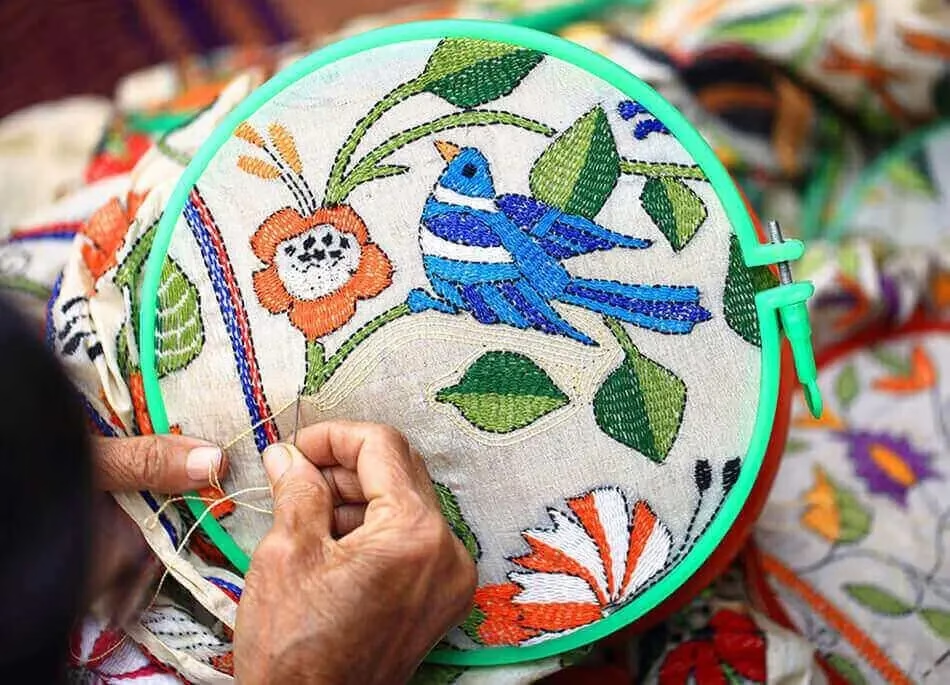
Leave a Reply